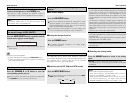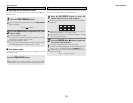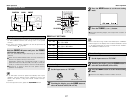
22
Basic Operation Basic Operation
3
Press the STANDARD button to select the
STANDARD (Dolby/DTS Surround) mode.
When performing this operation from the main unit’s panel,
press the SURROUND MODE button, then turn the SELECT
knob and select Dolby Pro Logic IIx or DTS NEO:6.
5
Press the SURROUND PARAMETER button.
• The surround parameter menu is displayed.
Play a program source with the or
symbol.
• The Dolby Digital indicator lights
when playing Dolby Digital
sources.
• The DTS indicator lights when
playing DTS sources.
lights
lights
4
Operate the SURROUND BACK button
to switch Surround Back CH ON/OFF.
• The SURROUND BACK indicator
lights when the SURROUND BACK
button is on.
• When making parameter settings, the display will return to the
regular condition several seconds after the last button was
pressed and the setting will be completed.
6
Press the SURROUND PARAMETER button, and
press the CURSOR
DD
or
HH
button to select the
various parameters.
7
Turn the SELECT knob, and press the CURSOR
FF
or
GG
button to adjust the parameter settings.
8
Press the ENTER button to finish the surround
parameter mode.
lights
2 Surround parameters e
CINEMA EQ. (Cinema Equalizer):
The Cinema EQ function gently decreases the level of the
extreme high frequencies, compensating for overly-bright
sounding motion picture soundtracks. Select this function if the
sound from the front speakers is too bright.
This function only works in the Dolby Pro Logic IIx, Dolby
Digital, DTS Surround and DTS NEO:6 modes. (The same
contents are set for all operating modes.)
D.COMP. (Dynamic Range Compression):
Motion picture soundtracks have tremendous dynamic range
(the contrast between very soft and very loud sounds). For
listening late at night, or whenever the maximum sound level is
lower than usual, the Dynamic Range Compression allows you
to hear all of the sounds in the soundtrack (but with reduced
dynamic range). (This only works when playing program
sources recorded in Dolby Digital or DTS). Select one of the
four parameters (“OFF”, “LOW”, “MID” (middle) or “HIGH”).
Set to OFF for normal listening.
LFE (Low Frequency Effect):
This sets the level of the LFE (Low Frequency Effect) sounds
included in the source when playing program sources recorded
in Dolby Digital or DTS.
If the sound produced from the subwoofer sounds distorted
due to the LFE signals when playing Dolby Digital or DTS
sources when the peak limiter is turned off with the subwoofer
peak limit level setting (system setup menu), adjust the level as
necessary.
Program source and adjustment range:
1. Dolby Digital: –10 dB to 0 dB
2. DTS Surround: –10 dB to 0 dB
When DTS encoded movie software is played, it is
recommended that the LFE LEVEL be set to 0 dB for
correct DTS playback.
When DTS encoded music software is played, it is
recommended that the LFE LEVEL be set to –10 dB for
correct DTS playback.
TONE:
This enables tone control. This can be set individually for the
separate surround modes other than PURE DIRECT and
DIRECT mode.
SB CH OUT (Surround Back):
(1) Multi-channel source
• OFF:
Playback is conducted without using the surround back
speaker.
• NON MTRX:
The same signals as those of the surround channels are
output from the surround back channels.
• MTRX ON:
The surround back channel is reproduced using digital matrix
processing.
• ES MTRX:
When playing DTS signals, the surround back signals undergo
digital matrix processing for playback.
• ES DSCRT:
When a signal identifying the source as a discrete 6.1-channel
source is included in the DTS signals, the surround back
signals included in the source are played.
• PLIIx Cinema:
Processing is performed with the Cinema mode of the PLIIx
decoder and the surround back channel is reproduced.
• PLIIx Music:
Processing is performed with the Music mode of the PLIIx
decoder and the surround back channel is reproduced.
(2) 2ch source
• OFF:
Playback is conducted without using the surround back
speaker.
• ON:
Playback is conducted using the surround back speaker.
This operation can be performed directly by pressing the
SURROUND BACK button.


















